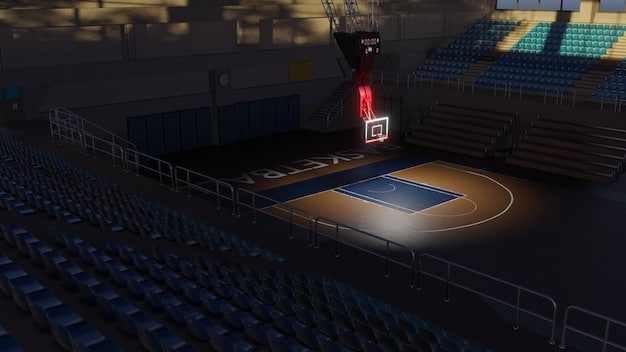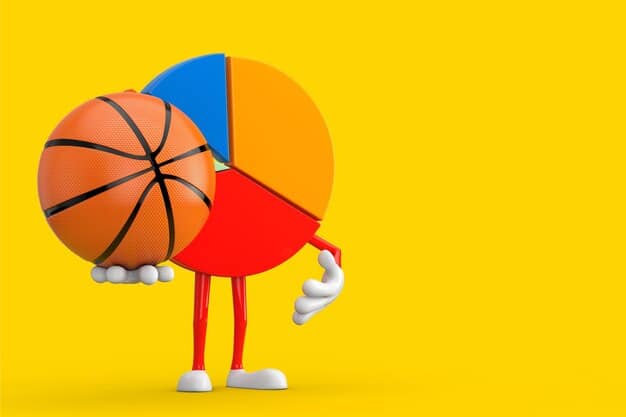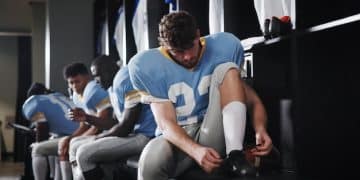NBA Salary Cap 2026: Projections & Implications for Player Contracts

NBA salary cap projections for 2026 are vital for teams and players, influencing contract negotiations, team building strategies, and player movement across the league as teams aim to maximize their spending power under evolving financial landscapes.
The NBA’s financial landscape is constantly evolving, and understanding future salary cap projections is crucial for teams and players alike. Let’s delve into the NBA salary cap projections for 2026, analyzing its potential impact on player contracts and team strategies.
Understanding the NBA Salary Cap
The salary cap is a limit on the total amount of money that NBA teams can spend on player salaries. It’s designed to promote competitive balance by preventing wealthier teams from hoarding all the best players. The cap is calculated based on the league’s revenue from the previous season.
How the Salary Cap is Calculated
The NBA’s salary cap is intricately tied to the league’s revenue. The specific formula, agreed upon by the NBA and the National Basketball Player’s Association (NBPA), takes a percentage of the league’s Basketball Related Income (BRI) and divides it among the 30 teams.
Importance of the Salary Cap
The salary cap introduces an element of strategic planning. Teams must carefully manage their payroll to stay competitive while adhering to the cap restrictions. It also impacts player contract negotiations and free-agent decisions.

- Promotes competitive balance across the league.
- Forces teams to prioritize strategic financial planning.
- Impacts player contract negotiations and free-agent decisions.
In conclusion, the salary cap’s calculation, rooted in BRI, coupled with its strategic importance, makes it a cornerstone of NBA financial and competitive balance, influencing every aspect of team management and player negotiations.
Factors Influencing Salary Cap Projections
Predicting future salary cap numbers is not an exact science. Several factors can influence the league’s revenue and, consequently, the salary cap. These factors include media deals, sponsorships, and overall league popularity.
Television Revenue
Television deals are a massive source of income for the NBA. Negotiations for new contracts can significantly boost revenue, thus impacting the future salary cap.
Sponsorships and Merchandise Sales
The performance of the league in terms of marketing and merchandise sales also adds to the Basketball Related Income. Higher revenues in these areas contribute to a higher salary cap.
NBA’s Popularity and Global Reach
Expanding the league’s global presence can result in increased revenue streams. The growth of the NBA’s international markets plays a significant role in projecting future revenue.
In summary, a variety of financial levers, from television deals to marketing revenues, shape the NBA salary cap. The league’s financial health and competitive balance depend on these projections and their potential impact.
NBA Salary Cap Projections for 2026
As of now, exact figures for the 2026 NBA salary cap are projections based on current trends and expectations for league revenue. Experts analyze these trends to provide estimates that teams use for their long-term planning.
Early Estimates and Predictions
Early estimates suggest a significant increase in the salary cap for 2026, driven by the anticipation of new TV deals and continued revenue growth. These estimates, however, are subject to change as more information becomes available.
Potential Increase Compared to Previous Years
The projected increase is expected to be substantial. Teams are closely monitoring these projections, as it will dictate their ability to sign new players and extend contracts of existing stars.
Impact of Collective Bargaining Agreement (CBA)
The specifics of the current CBA significantly impact projection methodologies. Any changes in the CBA could change the calculations.
- New TV deals and revenue growth could drive significant increases.
- Teams will need to adapt long-term strategies based on updated predictions.
- Future CBAs and economic conditions can change projections.
In conclusion, early projections for the NBA salary cap in 2026 suggest notable increases, with TV deals, revenue growth, and collective bargaining agreements playing pivotal roles in shaping players’ financial futures.
Impact on Player Contracts
The 2026 salary cap projections will have a profound impact on player contracts, especially those negotiated in the following seasons. Players and agents closely follow salary cap trends to maximize earning potential.
Negotiating New Contracts
With a higher salary cap, players can command larger contracts. Free agents and players eligible for extensions will be looking to capitalize on the increased financial flexibility of teams.
Extending Existing Contracts
Teams might be more willing to offer extensions to key players, securing their talent for the long term. The higher cap gives them the wiggle room to offer more lucrative deals.
Supermax Contracts
Supermax contracts, which are designated for elite players, will also increase in value, providing even more incentive for star players to stay with their current teams or seek such deals elsewhere.

In summary, the NBA salary cap projections for 2026 directly influence player contract negotiations, extensions, and supermax deals, impacting team-building strategies and players’ earning potential.
Team Strategies and Implications
Teams will strategize ways to best utilize their cap space in 2026. This involves making decisions about which players to pursue in free agency, who to trade, and how to structure contracts to maintain flexibility.
Free Agency
Teams will be evaluating potential free-agent targets and determining how much they are willing to spend to acquire their services. The increased cap space offers opportunities to sign top-tier talent.
Trade Market
Trades become more viable when teams have additional cap room. Teams could look to acquire players through trades, either to bolster their roster or to shed salary.
Developing Young Talent
Rather than spending heavily in free agency or the trade market, some teams might choose to focus on developing young talent. This strategy involves drafting well and nurturing players within the system.
In conclusion, teams’ approaches to the NBA salary cap projections for 2026 could include strategic spending in free agency, calculated trades, and a focus on nurturing young talent to stay competitive.
Long-Term Financial Planning
Understanding and planning for the 2026 salary cap is part of a larger long-term financial strategy for NBA teams. Smart management can help teams navigate the complexities of the salary cap and build a sustained competitive edge.
Building a Sustainable Roster
Teams need to create a roster that not only performs well in the short term but is also sustainable over time. Balancing veteran leadership with young talent is a key component of this.
Managing Future Cap Space
Knowing when to spend and when to save is crucial. Teams must anticipate future expenses and prepare for potential changes in the salary cap landscape.
Adapting to Changing Market Conditions
The NBA is a dynamic league, and market conditions can change quickly. Teams must be adaptable and ready to adjust their strategies as needed.
- Teams must balance veteran leadership with emerging talent.
- Prudent financial management is paramount for long-term success.
- Adaptability is key to navigating the ever-changing NBA.
In conclusion, a sustainable roster, prudent use of cap space, and adaptability define smart long-term financial planning for NBA teams navigating the 2026 salary cap and beyond.
| Key Aspect | Brief Description |
|---|---|
| 💰 Salary Cap Calculation | Based on league revenue, affects team spending. |
| 📈 Influencing Factors | TV deals, sponsorships, the NBA’s popularity. |
| ✍️ Player Contracts | Impacts negotiations, extensions, and supermax deals. |
| 🤝 Team Strategies | Impacts free agency, trade market, and talent development. |
Frequently Asked Questions (FAQ)
▼
The NBA salary cap is based on a percentage of the league’s Basketball Related Income (BRI) from the previous season, divided among the 30 teams. The NBPA and NBA agree on a formula.
▼
TV deals, sponsorships, merchandise sales, and the league’s overall popularity are key drivers that impact annual revenue and consequently, the available salary cap for teams to spend.
▼
A higher salary cap allows teams to offer larger contracts to free agents and veteran players. This boosts negotiating power for free agents seeking competitive or lucrative contracts.
▼
Teams adjust free agency targets, consider trades, and prioritize developing young talent based on current and projected cap space for smart decisions on team composition and future growth.
▼
Smart financial planning helps teams maintain competitive rosters, manage cap space efficiently, and adapt to changing market conditions for sustained success. This assures franchise stability.
Conclusion
Understanding the NBA salary cap projections for 2026 is essential for teams and players alike. As the league continues to evolve, strategic financial planning will be crucial for maintaining a competitive edge and navigating the complexities of player contracts.





